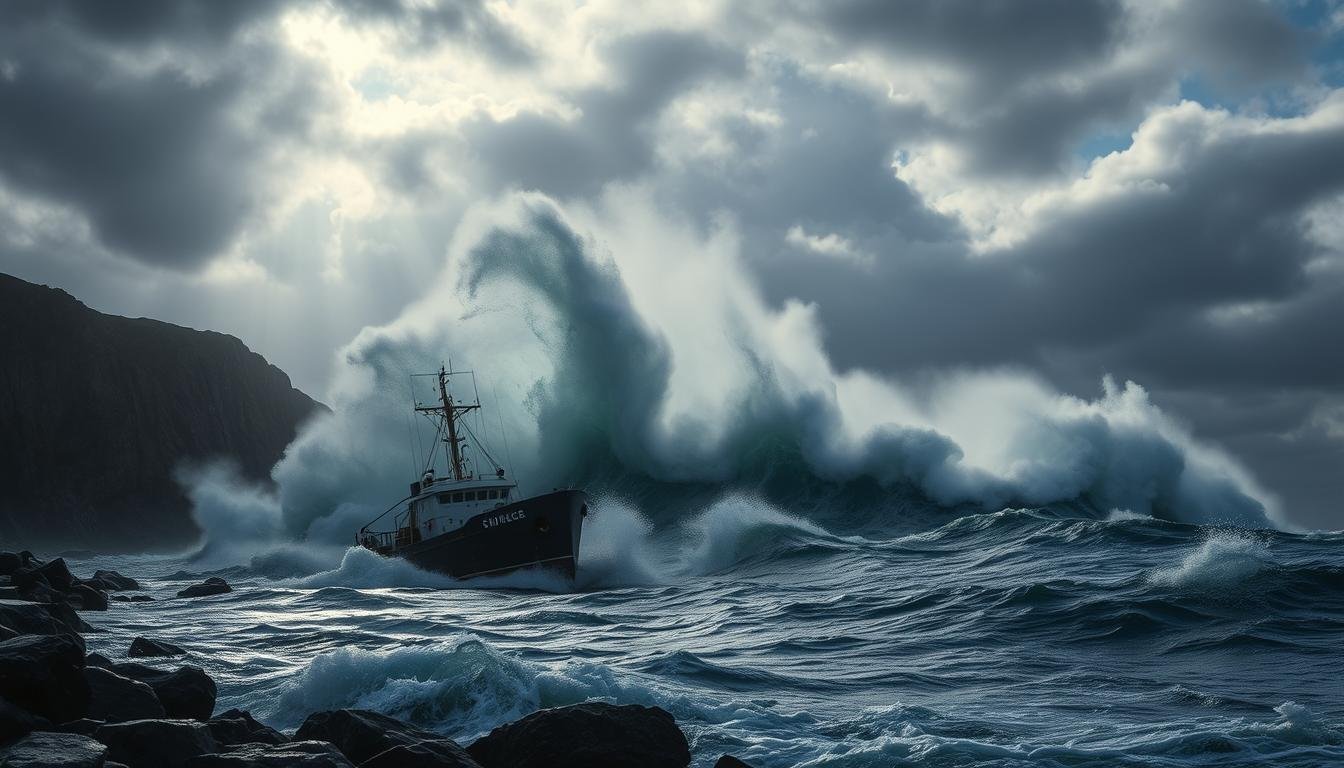Why Lake Superior is Dangerous for Ships? Navigating the Great Lakes can be tough, especially on Lake Superior. Knowing the hazards is key to safe travel.
The largest Great Lake is known for its unpredictable weather and unique geography. These can be big risks for ships. It’s important to understand these dangers.
There are many dangers on Lake Superior, like strong storms and hidden reefs. Knowing about these risks helps keep you safe.
While exploring the Great Lakes, you’ll find safety measures in place. Staying informed is your best way to avoid Lake Superior‘s dangers.
Contents
- 1 The Mighty Lake Superior: Geography and Weather Patterns
- 2 Storms and Wave Conditions
- 3 Why Is Lake Superior So Dangerous for Ships: Key Hazards
- 4 Infamous Shipwrecks and Maritime Disasters
- 5 Lessons Learned
- 6 Modern Safety Measures and Navigation Technology
- 7 Conclusion: Why Lake Superior is Dangerous for Ships?
- 8 FAQ
- 8.1 What makes Lake Superior so prone to storms?
- 8.2 How do wave conditions on Lake Superior impact ship safety?
- 8.3 What role does human error play in maritime accidents on Lake Superior?
- 8.4 How have modern safety measures improved navigation on Lake Superior?
- 8.5 What can ship operators do to minimize risks on Lake Superior?
- 8.6 How do Lake Superior’s geography and weather patterns affect ship routing?
The Mighty Lake Superior: Geography and Weather Patterns
Knowing about Lake Superior’s geography is crucial. It’s the largest of the Great Lakes, with a huge size and deep depth. This makes its weather very dangerous. It covers about 31,700 square miles and goes down to 1,332 feet in some spots.
The geography of Lake Superior leads to unpredictable weather. Weather over the lake can change fast because of its size and the land around it. This creates intense storms with high waves and strong winds, making it hard to navigate.
Storms and Wave Conditions
Storms on Lake Superior are very severe. The weather can change quickly, catching sailors by surprise. These storms can make waves over 20 feet high, sometimes reaching 30 feet or more.
The mix of Lake Superior’s geography and weather makes it deadly for ships. Knowing these factors is key for safe travel. By understanding the Lake Superior weather and taking precautions, ships can reduce risks.
Mariners need to be alert and ready for sudden weather changes. They should stay updated on weather forecasts and use the latest safety tech. This helps them navigate through the lake’s dangerous conditions.
Why Is Lake Superior So Dangerous for Ships: Key Hazards
Lake Superior poses many dangers, including geography, weather, and human mistakes. Knowing these risks is key to avoiding maritime disasters.
The unpredictable weather is a big concern. Storms can pop up quickly, bringing strong winds and huge waves. The lake’s geography, with cold air from Canada meeting warm air from the south, makes the weather even more unstable.
The lake’s rocky shores and shallow waters are also dangers. Plus, human mistakes can cause accidents. These errors can happen due to miscalculations or poor communication.
Some major hazards on Lake Superior are:
- Severe storms and high winds
- Rocky coastlines and shallow waters
- Human error and equipment failure
Knowing these dangers is vital for safe travel on Lake Superior. By understanding the risks and taking precautions, you can stay safe on this powerful lake.
The history of shipwrecks on Lake Superior shows its power. Learning from past disasters helps prepare for the challenges of navigating it.
Infamous Shipwrecks and Maritime Disasters
Did you know Lake Superior has seen many shipwrecks? These incidents have changed how we navigate the Great Lakes today. They’ve also led to better safety measures and technology.
The SS Edmund Fitzgerald sank on November 10, 1975, in a storm. All 29 crew members lost their lives. This tragedy is one of the most remembered on the Great Lakes.

The sinking of the SS Edmund Fitzgerald made a big impact. It led to better safety and navigation rules. Some key changes include:
- Improved weather forecasting and storm warnings
- More safety gear on ships
- Regular checks and upkeep for vessels
Other famous wrecks on Lake Superior are the SS Carl D. Bradley and the SS Chester A. Congdon. These, along with the SS Edmund Fitzgerald, helped create modern safety technology and stricter rules for navigation.
Lessons Learned
The history of shipwrecks on Lake Superior teaches us about safety and caution. By studying these incidents, we can keep improving safety and protect those who work on the lake.
Important lessons from these tragedies are:
- Always watch the weather
- Follow safety rules and regulations
- Invest in the latest safety tech and gear
By learning from the past and using these lessons, we can avoid more maritime disasters on Lake Superior.
Sailing on Lake Superior is now safer thanks to new safety rules and tech. You can count on advanced tech to lower risks on this vast and sometimes dangerous water.
Navigation tech has seen big improvements. Modern ships use Electronic Chart Display and Information Systems (ECDIS). This system gives real-time info on ship position, depth, and more. It has cut down on accidents caused by mistakes or old charts.
Also, safety rules have gotten better with mandatory reports and crew drills. Automatic Identification Systems (AIS) lets ships be tracked and monitored. This makes it faster to respond in emergencies.
The history of Lake Superior is filled with shipwrecks. But, thanks to these new safety steps, accidents have dropped a lot. By knowing Lake Superior’s power and using these tech tools, you can have a safer trip across its waters.
See Also: Why is San Luis Obispo Considered Dangerous? Insights
Conclusion: Why Lake Superior is Dangerous for Ships?
When you’re on Lake Superior, remember its strong reputation and dangers. Knowing the geography and weather helps keep you safe. Learning from shipwrecks is also key.
Today, safety tools and tech have made traveling safer. But, always respect the lake’s power and follow best practices. This way, you can avoid maritime disasters.
Respecting Lake Superior lets you enjoy its beauty while staying safe. Always be careful and alert when you’re on the water. This ensures a successful and safe journey.
FAQ
What makes Lake Superior so prone to storms?
Lake Superior’s location and geography make it prone to intense storms, especially in fall. Cold Arctic air meets warmer air from the Gulf of Mexico. This mix can lead to severe weather.
How do wave conditions on Lake Superior impact ship safety?
Wave conditions on Lake Superior are very hazardous. Waves can reach over 20 feet during storms. This can cause a lot of stress on ships, leading to damage or sinking.
What role does human error play in maritime accidents on Lake Superior?
Human error is a big factor in maritime accidents on Lake Superior. Mistakes by crew members, like navigational errors, can be very dangerous. This is especially true in the challenging environment of the lake.
Modern technology, like GPS and radar, has greatly improved safety on Lake Superior. Safety protocols, such as regular checks and emergency plans, have also reduced accident risks.
What can ship operators do to minimize risks on Lake Superior?
Ship operators should stay updated on weather, follow safety rules, and keep their vessels in good condition. They should also be ready for emergencies and have plans in place.
How do Lake Superior’s geography and weather patterns affect ship routing?
Lake Superior’s geography and weather patterns are key in ship routing. Captains must plan their route carefully. They need to avoid dangerous areas and use good weather for a safe journey.

Lorenzo Sloan is a safety advocate from Los Angeles who exposes hidden and everyday dangers through research-based blogging. With a background in social work, he aims to keep readers informed, cautious, and prepared for the unexpected risks around them.

